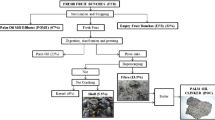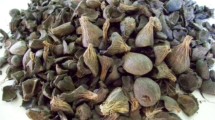Abstract
The increasing in greenhouse gas emissions, as well as solid waste disposal from the cement manufacturing industry and the Malaysian palm oil industries respectively contributes towards the undesirable 6°C Scenario envisioned by the International Energy Agency. The utilization of Palm Oil Fuel Ash (POFA) as partial cement replacement in the production of Oil Palm Shell (OPS) Lightweight Aggregate Concrete (LWAC) would significantly reduce cement consumption and amount of disposed landfill waste. In this investigation, the effect of POFA content as partial cement replacement towards the compressive strength of OPS lightweight aggregate concrete has been conducted. A total of six OPS LWAC mixtures were prepared with varying the percentages of POFA viz. 0%, 10%, 20%, 30%, 40% and 50% to determine the best replacement of POFA as partial cement replacement. The ashes were ground to enhance their pozzalanicity. The best replacement of POFA-20 was then used to investigate the mechanical properties of OPS LWAC such as compressive strength, flexural strength and modulus of elasticity. The concretes containing POFA were placed in different types of curing regimes namely water, air, sprayed and natural weather curing before subjected to compressive strength test and flexural strength test at the age of 28, 60, 180,270 and 365 days. The compressive strength was conducted in accordance with the BS EN12390-3 whilst the flexural strength test was carried out in accordance with the BS EN 12390-5. It was found that water curing is the best method amongst others. OPS LWAC with POFA exhibits the highest results of compressive strength, flexural strength and modulus of elasticity. The production of extra C-S-H gel resulting from better pozzolanic reaction for water cured OPS LWAC with POFA has contributed to the densification of the internal structure that in turn enhances the concrete strength.
Similar content being viewed by others
References
Abdul Awal, A. S. M. and Hussin, M. W. (1997). “The effectiveness of palm oil fuel ash in preventing expansion due to alkali-silica reaction.” Cement and Concrete Composites, Vol. 19, No. 4, pp. 367–372. DOI: 10.1016/S0958-9465(97)00034-6.
Abdullah, K., Hussin, M. W., and Awal, A. S. M. (2009). “Effect of curing regime on properties of lightweight concrete containing palm oil fuel ash.” Proceedings of the 1st International Conference on Building Science and Engineering (ICON BSE 2009), Johor Bahru, Malaysia.
ASTM Standard C494 (2005). Standard specification for chemical admixtures for concrete, ASTM Internationals, West Conshohocken, PA.
ASTM Standard C618 (2005). Standard specification for fly ash and raw material or calcined natural pozzolan for use as a mineral admixture in Portland cement concrete, Part 5. ASTM Internationals, West Conshohocken, PA.
Awal, A. S. M. (1998) A study of strength and durability performances of concrete containing palm oil fuel ash, Doctor Philosophy, Universiti Teknologi Malaysia, Skudai
British Standard Institution (1983). Testing concrete, method for determination of static modulus of elasticity in compression, London, BS 1881: Part 121.
BS EN 12390-3 (2009). Testing hardened concrete, Compressive strength of test specimens. London. BS EN 12390-3.
BS EN 12390-5 (2009). Testing hardened concrete, Flexural Strength of Test Specimens, London, BS EN 12390-5.
Budiea, A. M. B., El-Gelany, M. A. I., and Hussin, M. W. (2008a). “Durability of high strength pofa concrete.” Proceedings of the International Conference on Science and Technology Applications in Industry and Education, UiTM Permatang Pauh, Malaysia, pp. 1–4.
Budiea, A. M. B., El-Gelany, M. A. I., and Hussin, M. W. (2008b). “Study on acid resistance of high strength POFA concrete.” Proceedings of the 2nd Engineering Conference Sustainable Engineering Infrastructure, Development and Management (ENCON 2008), Kuching, Malaysia.
Chong, H. L. H., Chia, P. S., and Ahmad, M. N. (2013). “The adsorption of heavy metal by Bornean oil palm shell and its potential application as constructed wetland media.” Bioresource Technology, Vol. 130, pp. 181–186, DOI: 10.1016/j.conbuildmat.2014.10.010.
Duan, P., Shui, Z., Chen, W., and Shen, C. (2013). “Efficiency of mineral admixture in concrete: Microstructure, compressive strength and stability of hydrate phases.” Applied Clay Science, Vols. 83-84, No. 9, pp. 115–121, DOI: 10.1016/j.clay.2013.08.021.
Hu, C. H., Han, Y. G., Gao, Y. Y., Zhang, Y. M., and Li, Z. J. (2014). “Property investigation of calcium-silicate-hydrate (C-S-H) gel in cementitious composites.” Materials Characterization, Vol. 95, pp. 129–139, DOI: 10.1016/j.matcha.2014.06.012
Hussin, M. W. and Abdul Awal, A. S. M. (1996). “Influence of palm oil fuel ash on strength and durability of concrete.” Proceedings of the 7th International Conference on Durability of Building Materials and Components. Stockholm, Vol. 1, pp. 291–298.
Hussin, M. W., Abdullah, K., and Zakaria, F. (2008). “Utilization of palm oil fuel ash For optimum strength of aerated concrete.” Proceedings of the 1st International Conference on Civil Engineering (ICCE 2008), Kuantan, Malaysia.
Hussin, M. W., Muthusamy, K., and Zakaria, F. (2010). “Effect of mixing constituent toward engineering properties of POFA cement-based aerated concrete.” Journal of Materials in Civil Engineering, Vol. 22, No. 4, p. 287, DOI: 10.1061/(ASCE)0899-1561(2010)22:4(287).
Malaysian Standard. (2003). Portland cement (ordinary and rapidhardening): Part 1. Specification (Second revision), Malaysia, MS 522: Part 1.
Mannan, M. A. and Ganapathy, C. (2001). “Mix design for oil palm shell concrete.” Cement and Concrete Research, Vol. 31, No. 9, pp. 1323–1325, DOI: 10.1016/S0008-8846(01)00585-3.
Mannan, M. A. and Ganapathy, C. (2002). “Engineering properties of concrete with oil palm shell as coarse aggregate.” Construction and Building Materials, Vol. 16, No. 1, pp. 29–34, DOI: 10.1016/S0008-8846(01)00585-3.
Masazza, F. (1993). “Pozzolanic cements.” Cement and Concrete Composites, Vol. 15, No. 4, pp. 185–214, DOI: 10.1016/0958-9465(93)90023-3.
Megat Johari, M. A., Zeyad, A. M., Muhamad Bunnori, N., and Ariffin, K. S. (2012). “Engineering and transport properties of high-strength green concrete containing high volume of ultrafine palm oil fuel ash.” Construction and Building Materials, Vol. 30, pp. 281–288, DOI: 10.1016/j.conbuildmat.2011.12.007.
Meyer, C. (2009). “The greening of the concrete industry.” Cement and Concrete Composites, Vol. 31, No. 8, pp. 601–605, DOI: 10.1016/j.cemconcomp.2008.12.010.
Mo, K. H., Alengaram, U. J., Jumaat, M. Z., and Yap, S. P. (2015). “Feasibility study of high volume slag as cement replacement for sustainable structural lightweight oil palm shell concrete.” Journal of Cleaner Production, Vol. 91, pp. 297–304, DOI: 10.1016/j.jclepro.2014.12.021.
Mohamed, A. R., Lee, K. T., Noor, N. M., and Zainudin, N. F. (2005). “Oil palm ash/Ca(OH)2/CaSO4 absorbent for flue gas desulfurization.” Chemical Engineering and Technology, Vol. 28, No. 8, pp. 939–945, DOI: 10.1002/ceat.200407106.
Muthusamy, K. (2009). Properties of palm oil fuel ash cement based aerated concrete, Doctor Philosophy, Universiti Teknologi Malaysia, Skudai
Newman, J. B. and Choo, B. S. (2003). Advanced concrete technology, Butterworth Heinemann, UK.
Ozer, B. and Ozkul, M. H. (2004). “Influence of initial water curing on the strength development of ordinary Portland and pozzolanic cement concretes.” Cement and Concrete Research, Vol. 34, No. 1, pp. 13–18, DOI: 10.1016/S0008-8846(03)00185-6.
Shafigh, P., Alengaram, U. J., Hilmi, M., and Mohd Zamin, J. (2013b). “Engineering properties of oil palm shell lightweight concrete containing fly ash.” Materials and Design, Vol. 49, pp. 613–621, DOI: 10.1016/ j.matdes.2013.02.004.
Shafigh, P., Mohd Zamin, J., and Hilmi, M. (2010). “Mix design and mechanical properties of oil palm shell lightweight aggregate concrete: A review.” International Journal of the Physical Sciences, Vol. 5, No. 14, pp. 2127–2134.
Shafigh, P., Mohd Zamin, J., Hilmi, M., and Alengaram, U. J. (2013a). “Oil palm shell lightweight concrete containing high volume ground granulated blast furnace slag.” Construction and Building Materials, Vol. 40, pp. 231–238, DOI: 10.1016/j.conbuildmat.2012.10.007.
Shetty, M. S. (2005). Concrete technology theory and practice, S. Chand & Company Ltd. New Delhi, India.
Sideris, K. K., Manita, P., and Sideris, K. (2004). “Estimation of ultimate modulus of elasticity and Poisson ratio of normal concrete.” Cement and Concrete Composites, Vol. 26, No. 6, pp. 623–631, DOI: 10.1016/S0958-9465(03)00084-2.
Tanaka, K. and Kurumisawa, K. (2002). “Development of technique for observing pores in hardened cement paste.” Cement and Concrete Research, Vol. 32, No. 9, pp. 1435–1441, DOI: 10.1016/S0008-8846(02)00806-2.
Author information
Authors and Affiliations
Corresponding author
Rights and permissions
About this article
Cite this article
Muthusamy, K., Zamri, N.A. Mechanical properties of oil palm shell lightweight aggregate concrete containing palm oil fuel ash as partial cement replacement. KSCE J Civ Eng 20, 1473–1481 (2016). https://doi.org/10.1007/s12205-015-1104-7
Received:
Revised:
Accepted:
Published:
Issue Date:
DOI: https://doi.org/10.1007/s12205-015-1104-7




